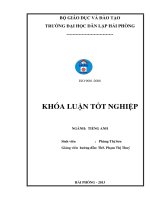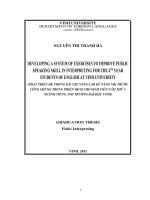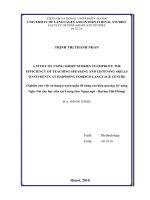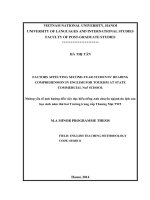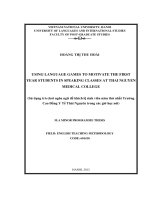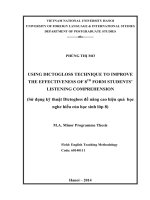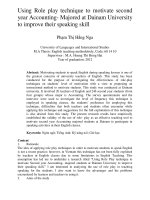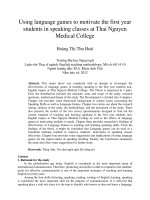Using debate technique to improve the speaking skill of the 3rd year students majoring in english for tourism at ha long university
Bạn đang xem bản rút gọn của tài liệu. Xem và tải ngay bản đầy đủ của tài liệu tại đây (1.4 MB, 116 trang )
NGUYỄN VÂN ANH
VIETNAM ACADEMY OF SOCIAL SCIENCES
GRADUATE ACADEMY OF SOCIAL SCIENCES
Nguyễn Vân Anh
COVER PAGE 2
ENGLISH LANGUAGE
USING DEBATE TECHNIQUE TO IMPROVE
THE SPEAKING SKILL OF THE 3RD YEAR
STUDENTS MAJORING IN ENGLISH FOR
TOURISM AT HA LONG UNIVERSITY
MA THESIS IN ENGLISH LANGUAGE
COURSE: 2016 – 2018
HANOI, 2018
VIETNAM ACADEMY OF SOCIAL SCIENCES
GRADUATE ACADEMY OF SOCIAL SCIENCES
Nguyễn Vân Anh
USING DEBATE TECHNIQUE TO IMPROVE
THE SPEAKING SKILL OF THE 3RD YEAR
STUDENTS MAJORING IN ENGLISH FOR
TOURISM AT HA LONG UNIVERSITY
Field: English Language
Code: 8220201
Supervisor: Assoc. Prof. Dr. Hồ Ngọc Trung
HANOI, 2018
DECLARATION BY AUTHOR
The researcher, Nguyễn Vân Anh, fully declares that this thesis “Using
Debate Technique to Improve the Speaking Skill of the 3 rd Year Students
Majoring in English for Tourism at Ha Long University” is the result of my own
progress of researching and I am the sole author of this thesis. With the
exception of the reference indicated in the thesis, to the best of my knowledge,
this thesis is conducted without using any other researchers and / or scholars.
Furthermore, this thesis is submitted and fulfilled the requirements of the M.A.
degree after a carefully examining progress.
Author’s Signature
Nguyễn Vân Anh
Approved by
SUPERVISOR
Assoc. Prof. Dr. Hồ Ngọc Trung
Date:……………………
i
ACKNOWLEDGEMENTS
This thesis is completed after many working hours, as well as the
contribution from numerous people with their effort, enthusiasm and assistance;
and this thesis is whole heartedly dedicated to them.
First and foremost, I would like to express my deepest gratitude to my
supervisor, Assoc. Prof. Dr. Hồ Ngọc Trung for all of his encouragement and
timely guidance. Had it not been for his support, in addition to his comments
and advice, I would not finish this thesis.
Next, I would like to convey my sincere appreciation and thanks to Mr.
Đặng Nguyên Giang and the staff of the Department of Foreign Languages,
Graduate Academy of Social Sciences for granting me the honor of writing this
thesis as well as their assistance and most valuable comments.
Additionally, I would be most grateful for all of the help from teachers at
Ha Long University. Their help encouraged me a lot in the progress of
completing the thesis.
Furthermore, I would like to send my special thanks to all of the students at
Ha Long University for their enthusiasm; their answers and responses helped
me a lot with the analysis of the thesis.
Last but not least, I would like to express my gratitude to my beloved
family, who always support me during the progress of conducting and finishing
this thesis.
ii
TABLE OF CONTENTS
DECLARATION BY AUTHOR ....................................................................... i
ACKNOWLEDGEMENTS .............................................................................. ii
ABSTRACT .................................................................................................... vii
LIST OF TABLES ......................................................................................... viii
LIST OF FIGURES .......................................................................................... ix
CHAPTER 1: INTRODUCTION .................................................................. 1
1.1. Rationale ................................................................................................. 1
1.2. Aim(s) of the Study ................................................................................. 2
1.3. Research Questions ................................................................................. 3
1.4. Scope of the Study .................................................................................. 3
1.5. Significance of the Study ........................................................................ 3
1.6. Research Methods ................................................................................... 4
1.7. Structure of the Study ............................................................................. 5
CHAPTER 2: LITERATURE REVIEW ...................................................... 7
2.1. Concepts of Speaking.............................................................................. 7
2.1.1. Definition of Speaking ...................................................................... 7
2.1.2. The Elements of Speaking ................................................................ 8
2.1.3. Principles of Teaching Speaking .................................................... 10
2.1.4. Teacher’s Roles in Teaching Speaking........................................... 11
2.1.5. Components of Teaching Speaking ................................................ 13
2.1.6. Techniques in Teaching Speaking .................................................. 15
2.1.7. Characteristics of Successful Speaking .......................................... 17
2.2. Concepts of Debate ............................................................................... 18
2.2.1. Definition of Debate ....................................................................... 18
2.2.2. Benefits of Debate........................................................................... 19
2.2.3. Debate as an active learning strategy.............................................. 20
2.2.4. Parts of Debate Technique .............................................................. 21
2.2.5. Procedure of Debate Technique ...................................................... 22
2.2.6. Debate Technique for the Improvement of Speaking Skills........... 23
2.3. Summary ............................................................................................... 24
iii
CHAPTER 3. METHODOLOGY ............................................................... 25
3.1. Setting of the Study ............................................................................... 25
3.2. General Situation of the Experimental Class ........................................ 25
3.3. Research Method................................................................................... 27
3.3.1. Action Research: An Introduction and the Reason for the choice .. 27
3.3.2. Research Design.............................................................................. 28
3.3.3. Target of Classroom Action Research ............................................ 29
3.4. Research Procedure ............................................................................... 30
3.4.1. Step 1: Planning .............................................................................. 30
3.4.2. Step 2: Action ................................................................................. 30
3.4.3. Step 3: Observation ......................................................................... 31
3.4.4. Step 4: Reflection ............................................................................ 32
3.5. Data Analysis ........................................................................................ 32
3.5.1. Method of Collecting Data ............................................................. 32
3.5.1.1. Observation ........................................................................... 32
3.5.1.2. Tests ...................................................................................... 33
3.5.1.3. Documentation ...................................................................... 34
3.5.2. Technique of Data Analysis ............................................................ 34
3.5.2.1. Mean ..................................................................................... 34
3.5.2.2. Standard Deviation ............................................................... 35
3.5.2.3. T-Test Analysis ...................................................................... 35
3.5.2.4. Reflection .............................................................................. 38
3.6. Summary ............................................................................................... 40
CHAPTER 4: FINDINGS AND DISCUSSIONS ....................................... 41
4.1. Findings and Discussions for Cycle 1................................................... 41
4.1.1. Planning .......................................................................................... 41
4.1.2. Action’s Implementation ................................................................ 41
4.1.3. Observation ..................................................................................... 43
4.1.4. Reflection ........................................................................................ 44
4.1.5. Test’s Result Calculation: Cycle 1.................................................. 44
iv
4.1.5.1. Calculating the Test Score ................................................... 44
4.1.5.2. Calculating Mean ................................................................ 45
4.1.5.3. Calculating the Standard Deviation and t0 ......................... 46
4.1.5.4. Interprpetation ..................................................................... 46
4.2. Findings and Discussions for Cycle 2 ................................................... 46
4.2.1. Planning .......................................................................................... 47
4.2.2. Action Implementation ................................................................... 47
4.2.3. Observation ..................................................................................... 50
4.2.4. Reflection ........................................................................................ 50
4.3. Findings and Discussions for Cycle 3 ................................................... 50
4.3.1. Planning .......................................................................................... 51
4.3.2. Action Implementation ................................................................... 51
4.3.3. Observation ..................................................................................... 53
4.3.4. Reflection ........................................................................................ 54
4.3.5. Test’s Result Calculation: Cycle 2 and Cycle 3.............................. 54
4.3.5.1. Test’s Results ........................................................................ 54
4.3.5.2. Calculating Mean ................................................................ 56
4.3.5.3. Calculating the Standard Deviation and t0 .......................... 56
4.3.5.4. Interprpetation ..................................................................... 56
4.4. Cycle 4 .................................................................................................. 57
4.4.1. Planning .......................................................................................... 57
4.4.2. Action’s Implementation ................................................................ 57
4.4.3. Observation ..................................................................................... 59
4.4.4. Reflection ........................................................................................ 59
4.4.5. Test’s Result Calculation: Cycle 4.................................................. 60
4.4.5.1. Test’s Results ....................................................................... 60
4.4.5.2. Calculating Mean ............................................................... .61
4.4.5.3. Calculating the Standard Deviation and t0 .......................... 62
4.4.5.4. Interprpetation ...................................................................... 62
4.5. Summary ............................................................................................... 62
v
CHAPTER 5: CONCLUSION ..................................................................... 64
5.1. Recapitulation ....................................................................................... 64
5.2. Concluding Remarks ............................................................................. 64
5.3. Implications ........................................................................................... 65
5.4. Limitations and Suggestions for Further Studies .................................. 65
REFERENCES ................................................................................................ 69
APPENDIX 1: LESSON PLANS ...................................................................... I
Lesson Plan for Debate Activity – Cycle 1..................................................... I
Lesson Plan for Debate Activity – Cycle 2.................................................. III
Lesson Plan for Debate Activity – Cycle 3................................................... V
Lesson Plan for Debate Activity – Cycle 4................................................ VII
APPENDIX 2: TESTS .................................................................................... IX
Pretest 1 ........................................................................................................ IX
Post-test 1 .................................................................................................. XIII
Post-test 2 ................................................................................................... XX
Post-test 3 ................................................................................................ XXX
Post-test 4 .............................................................................................. XXXII
vi
ABSTRACT
There are numerous ways of improving speaking ability for students, and
this thesis is conducted not beyond this purpose. In particular, this thesis mainly
focuses on the way of applying Debate Technique in teaching speaking,
especially in the scope of universities. Generally speaking, Debate Technique is
considered one of the most effective ways of teaching speaking skills; and
applying this teaching method in classes showed the evidence of effectiveness in
reality. Additionally, it is undeniable that using Debate Technique, in teaching
English in general and the skill of speaking in particular, now becomes more and
more popular at schools and universities because of the value it brings.
Therefore, this thesis concentrates on the implementation of Debate Technique
and proves that its use can help student’s speaking skills to be enhanced. After
analyzing and synthesizing the statistics, the researcher discussed and
recommended some implications along with suggestions for further research.
Finally, it is much hoped that the results of the study could be useful for the
development of teaching and learning English speaking skill at Ha Long
University.
vii
LIST OF TABLES
Table 3.1: List of the members of the Experimental Class ............................. 25
Table 3.2: Teaching aspects for an observation sheet ..................................... 31
Table 4.1: Team division: Cycle 1 .................................................................. 42
Table 4.2: Observation checklist – Cycle 1 .................................................... 43
Table 4.3: Test score – Cycle 1 ....................................................................... 45
Table 4.4: Value of Mean – Cycle 1 ............................................................... 45
Table 4.5: Team division: Cycle 2 .................................................................. 48
Table 4.6: Observation checklist – Cycle 2 .................................................... 49
Table 4.7: Team division: Cycle 3 .................................................................. 52
Table 4.8: Observation checklist – Cycle 3 .................................................... 53
Table 4.9: Post-test Score – Cycle 2 and Cycle 3 ........................................... 55
Table 4.10: Value of Mean: Cycle 2 and 3 ..................................................... 56
Table 4.11: Team division: Cycle 4 ................................................................ 58
Table 4.12: Observation checklist – Cycle 4 .................................................. 58
Table 4.13: Test score – Cycle 4 ..................................................................... 60
Table 4.14: Mean calculation – Cycle 4.......................................................... 61
viii
LIST OF FIGURES
Figure 3.1: Action research cycle proposed by Wilf Carr and Stephen Kemmis
(1986) .............................................................................................................. 27
Figure 3.2: T-Test distribution figure………………………………………..37
Figure 3.3: Process of a debate action............................................................. 39
Figure 4.1: Mean of the Post-test from Cycle 1 to 4 ....................................... 61
ix
CHAPTER 1: INTRODUCTION
1.1. Rationale
English increasingly affirms its indispensable role in all exchange activities
and international cooperation in all fields of economics, politics, culture,
education, science, health care and social life, etc. of most countries and regions
in the world. To Vietnam, we also clearly identify the position of the language
for the overall development of society as a tool for facilitating integration into
the international and regional communities, a tool to access to global
information, science and technology and a tool to approach other cultures as
well as important worldwide events. Therefore, English has become a
compulsory subject in all colleges and universities throughout the country for
many years. Also, Vietnamese educators increasingly become aware that one of
the decisive elements which contributes to learners’ success is his/her
competence in English. And “How to help students communicate confidently in
English?” is the question which always ponders every teacher of English at
every foreign language training institution.
Theoretically speaking, good grammar, good vocabulary and good
pronunciation help us communicate well. The ultimate goal of every English
learner is to be able to communicate in English at various degrees depending on
the individual's job requirements. However, communicating well in English is
not an easy-to-achieve goal to almost English learners, especially to Vietnamese
learners of English. To students who major in English for tourism at Ha Long
University, communicating well in English is really significant because it is the
key tool of their future job. In order to communicate well in English, students
must be good at speaking skills by mastering speaking elements including
grammar, vocabulary, pronunciation and fluency. But, frankly speaking, most of
these students usually face difficulties which prevent them from participating
eagerly in the speaking lessons. After over ten years of teaching English at Ha
Long University (formerly Ha Long College of Culture, Art and Tourism), I
noticed that many students are timid, not excited during hours of speaking
1
lessons even when they are good at vocabulary and grammar. This means that
students are possibly not interested in the subject or have not found effective
learning methods for this subject. So, how to stimulate students to be actively
involved in the speaking activities in the class is a difficult question to answer.
One of the reasons why students’ motivation in speaking classes is low is
that they do not have many chances to practice English inside and outside the
class. There are several techniques which teachers can use to stimulate students
to participate in the speaking lessons. The chosen technique should be
interesting enough to inspire students to the speaking activities. One of the
appropriate techniques for teaching speaking skills is debate technique. It is
recognized as an active learning strategy through which students will learn more
through a process of constructing and creating, working in a group and also
sharing knowledge. Debate is a teaching strategy to improve verbal
communication and critical-thinking skills. Debating is an effective pedagogical
strategy because of the level of responsibility for learning and active
involvement required by all student debaters. Maryadi (2008, p.16) states that
“debate can motivate students’ thinking, moreover if they must defend their
stand or opinion which is in contradiction with conviction themselves”. This
strategy can involve all students to be active, not only debate performer. For the
above-mentioned reasons, I have decided to carry out a study entitled “Using
Debate Technique to Improve the Speaking Skill of the 3 rd Year Students
Majoring in English for Tourism at Ha Long University” for my MA thesis.
1.2. Aim(s) of the Study
The aim of the study is to improve the speaking skills of third year students
who major in English for Tourism at Ha Long University by using debate
technique. In order to achieve the aim, the study is expected to fulfill the
following objectives:
(i) Describing the use of debate technique in teaching the speaking skill to
third year students majoring in English for Tourism at Ha Long University;
2
(ii) Identifying how much students’ speaking skill improve after being
taught by using debate technique.
1.3. Research Questions
For the objectives of the study, the following research questions are addressed:
1. How is the debate technique used to improve the speaking skill of third
year students majoring in English for Tourism at Ha Long University?
2. How much do students improve their speaking skill after using debate
technique?
1.4. Scope of the Study
Within the MA thesis, the present study involves the investigation of what
the students truly do during the debates in their speaking lessons and its impacts
on the communicative competence of 19 major English students who are in the
third year of a three-year English for tourism program at the Faculty of Foreign
Studies, Ha Long University. Debate is experimented as an intensive
methodology in speaking lessons in one class during a fifteen-week semester.
1.5. Significance of the Study
In our contemporary society, people are living in an information-rich one
with increasing numbers of media sources, the growth of the internet and the
emergence of social media and they affect the way people teach foreign
language. Young people today not only need to have the skills needed to
understand the information being presented, they need to have the skills to
research through different sources, critically analyze the information presented
and form their own conclusions and arguments as a result. The changes motivate
the teacher to change and renew their teaching method, and applying debate
activities is one of them. Debate can also help to broaden horizons, improve
cultural awareness and bring together young people from diverse backgrounds.
There is evidence that debate can be particularly powerful when working with
students from more disadvantaged backgrounds, boosting their confidence and
even increasing aspirations for higher education.
3
Furthermore, for all students, debating activities are good preparation for
further study and help to develop the skills which will be vital when coming to
university level study. The research element of debate in particular helps
students to develop library research skills, self-managed study and time
management. It also introduces students to more in-depth analysis of a particular
topic that is often difficult to introduce within the curriculum.
In the context of the study, firstly, in this study the students are expected to
be able to improve their speaking skills by using debates. Secondly, the study is
hoped to help teachers to get alternative ways in their teaching process,
especially by using debates. Additionally, the readers are expected to obtain any
information in order to improve their knowledge by reading this thesis. And
finally, to the writer, this thesis helps her develop knowledge and experience in
composing academic writing.
1.6. Research Methods
This study is a classroom action research. Undoubtedly, action research is
an attractive selection for teacher researchers, school administrative staff in the
teaching and learning environment to consider. Distinctively, action research in
education can be defined as the process of studying a school situation to
recognize and pick up the quality of the educative procedure. It is responsible
for practitioners about new knowledge and perception about how to enhance
educational practices or resolve important problems in classrooms and schools.
Within the context of this study, the main goal of action research is to determine
ways to enhance the speaking skills of the students at Ha Long University.
Simultaneously, action research can enhance the lives of those professionals
who work within educational systems. Using action research to be the research
method of this study helps teachers develop new knowledge directly related to
their classrooms, promotes reflective teaching and thinking, expands teachers’
pedagogical repertoire, puts teachers in charge of their craft, reinforces the link
between practice and student achievement, fosters an openness toward new
ideas and learning new things, and gives teachers ownership of effective
4
practices. Moreover, action research workshops can be used to replace
traditional, ineffective teacher in-service training as a means for professional
development activities. To be more applicable, teacher in-service training needs
to be extended over multiple sessions, contain active learning to allow teachers
to manipulate the ideas and enhance their adjustment of the information, and
align the concepts showed with the current curriculum, goals, or teaching
concerns. Consequently, providing teachers with the necessary skills,
knowledge, and focus to engage in meaningful inquiry about their professional
practice will enhance this practice, and effect positive changes concerning the
educative goals of the learning community.
The data collection will be done using test and observation. The data from
the test and observation is going to be taken from every stage and analyzed
quantitatively. The participants of this study are 19 students in class English for
Tourism 3. The result of this study will tell us how using debate technique can
improve students’ speaking skills.
1.7. Structure of the Study
This paper is divided into five chapters.
Chapter 1 briefly introduces the background information of the study, the
reasons why the writer chooses the topic for her MA thesis, the aims, objectives
of the study and the research questions which are going to be addressed in the
study. The scope of study, its significance and structure are also raised in this
chapter.
Chapter 2 consists of theoretical framework of teaching speaking skills
and the debate technique and previous studies related to the thesis.
Chapter 3, the methodology chapter, will make it clear how the present
study was implemented, including information about context, participants, and
procedures, instrumentation and data collection. Methods of analysis will also be
addressed in this chapter. Analysis of a range of data collected from various
sources (oral data from group planning and individual presentations, teacher’s
observation notes) for the study will be clarified in this chapter.
5
Chapter 4 will present findings from the present study and discuss these
results.
Chapter 5, which is also the concluding chapter of the study includes
conclusion, implications, limitations of the study and suggestions for further
studies.
6
CHAPTER 2: LITERATURE REVIEW
2.1. Concepts of Speaking
2.1.1. Definitions of Speaking
Right from the establishment of the human society, speaking has been
being used as one of the most common ways of communicating. According to
the viewpoint of Fulcher (2003), speaking is the verbal use of language to
communicate with others. People use speaking to form social relationship,
express their ideas or give commands to the others. Whenever a person produces
a short piece of spoken sentences, it is called a speech. Speech has a close
relation with making choices. Particularly, speakers have to make a proper
choice of the way of interaction to express themselves and describe what they
need to other persons.
Speaking is also defined by Eckard & Kearny (1981), Florez (1999) and
Howarth (2001) that it is “a two-way process involving a true communication of
ideas, information or feelings”. This view reflects the spoken texts or the
creation of collaboration between two or more participants simultaneously, and
a shared physical situation.
Additionally, according to Burns & Joyce (1997) and Luoma (2004, p.2)
speaking is defined as “an interactive process of constructing meaning that
involves producing, receiving and processing information”. Its form and
meaning are reliant on the situation in which it happens, containing the
contributors themselves, the physical setting, and the purposes for speaking. It is
often impulsive, open-ended, and growing.
Another definition given by Louwerse & Mitchel (2003, p.243), that
speaking is a process using a language proficiently and is taken for granted,
because the competence of speaking is an innate ability to each individual since
they were born. Because of this reason, speaking is a natural progress of five
main components, including using language in a person’s ordinary voice,
7
uttering words, understanding and being able to say words, expressing one self’s
opinions in words and making speech.
Besides, the variety of the number of languages all over the world is one
of the most outstanding factors causing the advent of learning foreign languages.
Because the necessity of speaking in general and speaking another language, in
addition to an individual’s mother tongue, it is considered one of the most
important skills to learn.
Generally speaking, it can be concluded that speaking is the process of
constructing a person’s ideas; in other words, it is a way a person shows other
people his or her feelings and communicates effectively by words and phrases.
2.1.2. The Elements of Speaking
According to Harmer (2003, p.288), there are two main factors that
English-speaking competence presupposes the significance for spoken
production, which will be mentioned below:
2.1.2.1. Language Features
According to Dalton and Seidlhofer (1994), the characteristics of language
in general and speaking in particular can be categorized into four main aspects,
including Connected speech, Expressive devices, Lexis and Grammar and
Language of negotiation.
It is claimed that in connected speech, sounds are undergone some different
processes; in particular, they are modified (assimilation), omitted (elision),
weakened (by using contractions and patterning) or added (linking). Because
of this processes, it is necessary for teachers to involve students in classroom
activities which are designed in special purposes in order to enhance their
connected speech.
Expressive devices: In English-speaking countries, this aspect of language
feature is showed by people who use it as their first language to alter not
only their pitch and word stress in certain parts of utterances, but also the
way of using their volume and speaking speed, and is showed by other
8
paralinguistic (non-verbal) and physical means like emotion (especially in
face-to-face conversation).
Lexis and Grammar:
A wide range of vocabulary and phrases could be used by teachers for
numerous teaching functions, including expressing feelings or emotions,
showing his or her agreement or disagreement, giving orders or showing
approval.
Language of negotiation:
Effective speaking gets benefits from the language of negotiation that
speakers use to get hold of the ideas’ clarification and present the content’s
structures of what we speak. We usually require this kind of clarification during
the conversation, when we are focusing on the content of the speech. This
feature is, obviously, very necessary to students.
2.1.2.2. Social Processing
It is also said by Harmer (2003, p.294) that whether speaking is effective or
not depends on the processing skills which are very important, particularly:
Language processing: this skill involves the ability of getting learned
vocabularies back of students and their way of combining words into a
propositionally and syntactically suitable sequence.
Communicating with others: on the purpose of sharing ideas and opinions
with others in a natural, effective and spontaneous way, it is required from
speakers a good skill of listening, and they have to comprehend almost
correctly the emotions of the person to whom he or she is talking as well.
Furthermore, the speaker has to have a certain range of social and
linguistic knowledge to analyze the content of his or her partner. If all of
these criteria are fulfilled, communicators can take turns in the
conversation
9
2.1.3. Principles of Teaching Speaking
2.1.3.1. Concept of Teaching Speaking
In the book “How to Teach Speaking” written by Thornbury (2005), the
concept of teaching speaking was mentioned as a main way of delivering the
knowledge of English language to the students. The details of this concept
mentioned by this author will be mentioned below.
Generally, teaching speaking is a long-term progress commencing at giving
the students instructions to produce and express their ideas in English or any
kinds of foreign languages and more importantly, guide them a way to
pronounce this novel language correctly. After that, the teacher continues to give
students instructions on where they can start to assess their sound productions,
basing on certain criteria. When students can do this process of assessment on
their own, the primary role of the teacher to fix their potential mistakes no
longer exists; however, the teacher in class still plays an important role. They
should be able to give appropriate encouragement to stimulate students’ interest
in speaking and ask them to talk, repeat and imitate themselves more regularly.
According to Nunan (1991, pp.54 – 56), there are five main principles of
teaching speaking. These principles will be listed and explained thoroughly in
the next sections.
2.1.3.2. Five main Principles of Teaching Speaking
Awareness of Difference:
It is unavoidable that there are obvious discrepancies between the context
of teaching and learning a second language and foreign language. In particular, a
foreign language context is the one which has the target of learning speaking in
a special environment, not a communicative language popular in the
community; On the contrary, a second language context’s target language is,
absolutely, the language of communication purpose in the society. Because of
this reason, when teaching speaking, teachers should pay attention to this feature
to conduct suitable speaking activities.
10
The Importance of Fluency and Accuracy:
Generally, it can be understood that accuracy in speaking is the extent of
speech in which what students spoke matches what people, especially native
people, use in communicative activities; and fluency – in another extent – is the
ability of using language quickly and confidently with little hesitations of pauses
in an unnatural way or time-consuming word search from speakers.
Because fluency and accuracy are of great importance to the effectiveness
of communication, teachers should pay serious attention to teaching and guiding
students to be better at these features.
Providing Opportunities:
Giving students chances to talk is also a good way to increase the speaking
ability of students. Teachers should do it more regularly in class and encourage
all students in class to jump at the chances of speaking.
Tasks Planning:
It is understandable that having a well-prepared teaching plan will allow
teachers to be more organized and the effectiveness of the lesson will be
increased.
Designing classroom activities
In a speaking lesson, classroom activities are important because they help
students to involve in the target speaking language more effectively. In order to
design appropriate activities for students, teachers should spend a certain
amount of time to research the class situation.
2.1.4. Teacher’s Roles in Teaching Speaking
According to Harmer (2007), teachers play a significant role in teaching
speaking, including:
Applying the language students are learning to deal with the subject
matters and besides, stimulate the involvement of students in the class.
Asking the least amount of display questions. In other words, teachers
should encourage students to “display” their background and subject
11
knowledge by asking questions instead of giving information directly. For
instance: “What is the noun form of communicate?”
Building the speaking topic with the students and giving advice and
comment to each of their contributions.
Encouraging students to speak as much as they can by giving some further
suggestions basing on what students have just spoken and trying not to
use a student’s short utterance to be a springboard for another lengthy
turn.
Including a clarification of the intention of what students say by extending
your opportunities to another student and trying not to cut off an exchange
too early.
Taking serious notice of the usage of natural feedback rather than
assessing or evaluating the utterance of the students and ask them to
follow the judgment deliberately.
Giving an explicit credit to the students by quoting them and trying not to
take credit for the contribution that students have made by giving the
intention for the content of the conversation that the teacher had prepared
previously.
From the above-mentioned features, it can be seen that in speaking
activities, like any other types of classroom procedure, the role of teachers is of
great importance. However, basing on the viewpoint of Brown (2009), there are
three most outstanding roles that require more concentration from the teacher:
Prompter: During speaking activities, owing to various reasons, students
can get lost or cannot think of what should be spoken from time to time,
or even have trouble with fluency and pronunciation. In order to help
students, teachers can leave them to deal with the struggle on their own
and ask them when they come up with a possible solution.
Participant: Students are the main participants of every speaking activity,
so the teacher should be a good guide and also a model participant when
requiring them to speak.
12
A person who gives proper feedback: After each student presents their
ideas or produces a short piece of speaking, teachers should immediately
give comments to encourage the students. However, if there are some
points that students need to improve, teachers should also let them know.
2.1.5. Components of Teaching Speaking
According to Carrasquillo (1994, p.55), there are five components which
are often analyzed in a process of speaking, including:
Pronunciation
It is widely known that pronunciation is a useful technique for pupils to
create clearer language during the speaking process. It means that learners can
communicate efficiently when they have decent pronunciation and intonation in
spite of having inadequate vocabulary and grammar. Pronunciation could be
mentioned with the traditional or regular expression of words (Kline, 2001,
p.69). Furthermore, according to Gilbert (2008, p.1), English articulation is not a
mastery of sounds or isolated words. As an alternative, it is related to learning
and applying the way of making a speaker’s opinions and feelings become easier
for listeners to follow. In addition, pronunciation comprises all those
characteristics of speech which is an intelligible flow of speech, including
“segmental articulation, rhythm, intonation and phrasing, and more peripherally
even gesture, body language and eye contact.” (Fraser, 2001, p.6).
Grammar
Grammar is necessary for the students to create an appropriate expression
in conversation, both in written and oral forms. In general, the definition of
grammar can be given as an organized way of accounting for and forecasting a
model knowledge of the language of both speakers and listeners, which is done
by a set of instructions or philosophies that can be used to create all well-formed
or grammatical utterances in the language (Purpura, 2004, p.6).
On the other hand, according to Batko (2004, p.24), grammar refers to the
fundamental principles and structure of the language, including clear and correct
13
sentence construction and the proper forms of words. Having an agreement with
this opinion, Harmer (2001, p.12) noted that the grammar aspect of a language,
especially second language, is the portrayal of the techniques in which words
can be under a modification in their forms and jointed into sentences in that
language. Because of its function, grammar is used to avoid misapprehension
among members of a conversation.
Vocabulary
Vocabulary is considered the most significant thing in a language,
especially in speaking because the more words the students know, the easier
they get to express their thoughts, emotional states and ideas in both oral or
written form. According to Turk (2003, p.87), in spoken language, the
vocabulary tends to be familiar and aims at daily-life use. It means that in
spoken language, the vocabulary used have to be very acquainted and used in
everyday conversation on the purpose of understanding the spoken discourse. In
order to use words in speaking proficiently, students need to remember their
meanings, spelling and pronunciation. Consequently, when teaching vocabulary,
the teachers need to make certain that the explanation of the meaning, as well as
the spelling and pronunciation are conveyed correctly.
Fluency
According to Pollard (2008, p.16), fluency is defined as the capability to
speak fluently, confidently and accurately. Generally, it refers to the expression
of oral language freely without pause or stoppage. In the process of teaching and
learning speaking skills, if the teacher wants to check how fluent his or her
student is, he or she can let them express themselves freely and see the level of
interruption from the speech. However, the teacher should not fix the mistake
immediately; he or she should encourage the students and praise them if
necessary.
14


